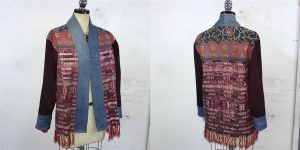Repurposed Garments: Challenges During Production

Repurposed jacket by Factory8 for JoeyWolffer.com
As we discussed in last week’s blog entry, repurposed garments, (also known as upcycled clothing), is the creative reuse of existing garments or materials into entirely new designs, with minimal application of new materials. It is a sustainable process that transforms waste materials or unwanted products into new materials or garments of better quality or for better environmental value. Working with repurposed garments is something we at Factory8 enjoy immensely, mostly because it’s just fun! How can you take an outdated fashion, or a piece of unwanted material, and transform it into something entirely new and exciting? In terms of creativity, the sky is the limit!
However, when thinking about how to scale this one piece out into production, you have to start thinking “inside” the box, or rather, how best to utilize the pieces of your design in a manner that will allow them to be efficiently and easily scaled out into production. During production, many different hands at many different stages along the labor supply chain will be contributing to the garment’s final completion, so it’s important to reduce as many variables as possible in the construction and pattern-making end of the re-purposed style. However, if you have these concepts in mind when you are designing the very first one-off repurposed first sample, it will make the production process that much smoother in the end.
Some of the drawbacks of scaling out re-purposed garments for production include:
- It makes fulfilling reorders difficult—as many stores will expect their re-orders to be exactly the same as the first order. However, if the buyers understand that there may be variance due to available materials the second time around, then it is not a problem.
- Each piece is usually one of a kind—which can provide challenges for ecommerce platforms where buyers cannot see directly what piece they are purchasing.
- As mentioned above, it can be difficult to translate into assembly line style work, due the individual nature of each garment, which can make the labor cost more expensive than it might be to produce a garment from scratch.
- Sizing may be variable, or hard to achieve, depending on the style/fit.
However, many are finding that the benefits of scaling out re-purposed garments for production can outweigh the cons:
- Each piece is usually one of a kind!
- Materials cost is low or non-existent, due to re-using materials, deadstock or unsold inventory.
- Carbon footprint is low due to not using energy to produce new materials, and preventing old materials from becoming waste.